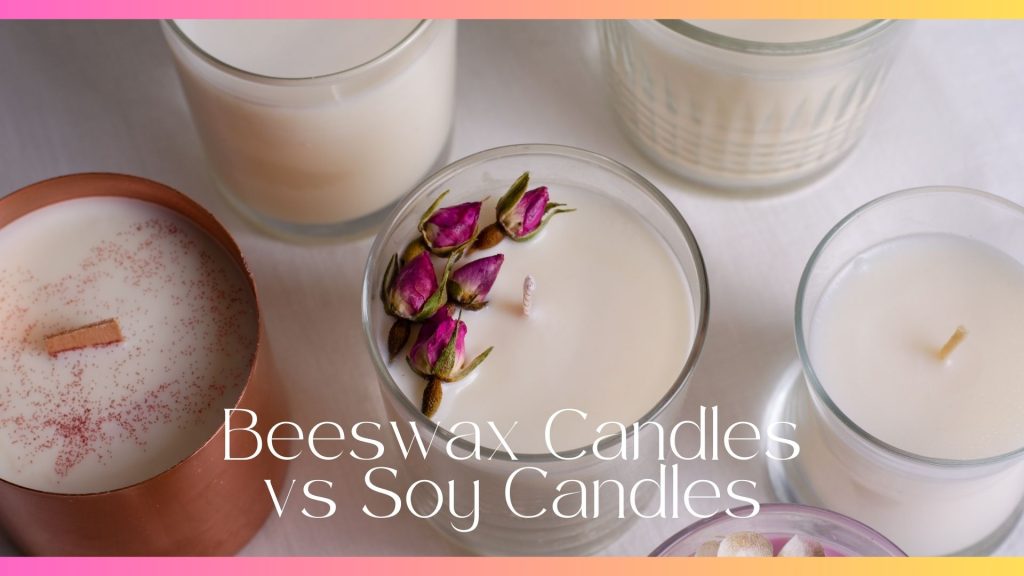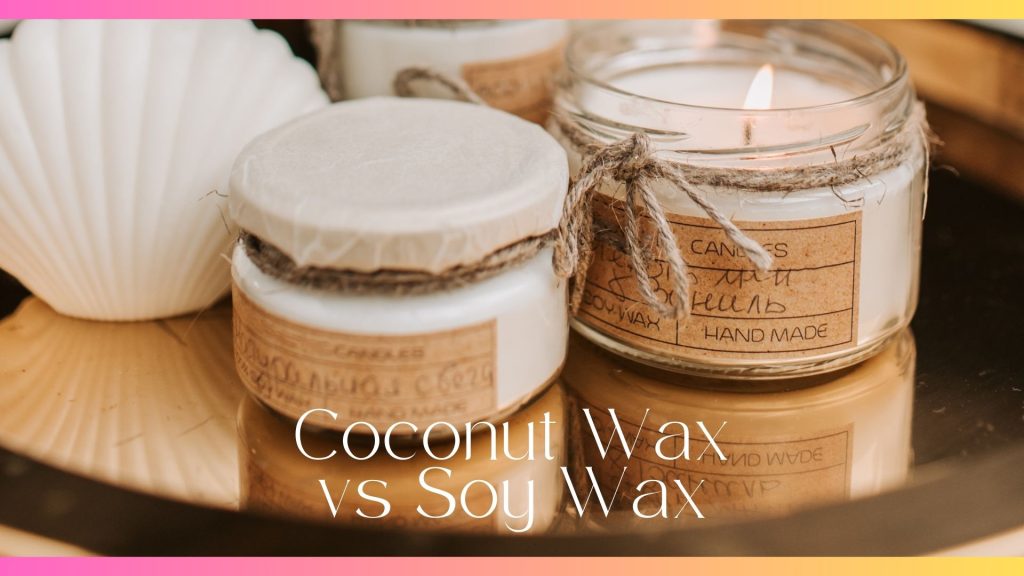Don’t know what’s your coconut wax candle burn time? Unsure if your products can burn as long as other candles in the market? Here’s what you need to know!
While candle-making can be a straightforward process, creating the perfect candles take time and a lot of testing.
In this article, I’ll share more on how you can identify the burn time of your coconut wax candles and factors that affect your final products.
Disclaimer: This post may contain affiliate links. This means I may earn a small commission (at no cost to you) if you sign up for a program or make a purchase using my link!
Related Posts:
- Soy Candles vs Coconut Candles for Candle-making
- How To Make Coconut Wax Candles with Essential Oils
- How Long Do Coconut Wax Candles Need To Cure?
What is Coconut Wax?
Before understanding the burn time, you should know what how coconut wax candles are made.
Similar to soy wax, coconut wax is made of hydrogenated coconut oil, which involves only natural ingredients that are sustainable and renewable. Coconut wax is both eco-friendly and vegan-friendly, which makes it a favorite among eco-conscious consumers and candle-makers.
When it comes to candle-making, coconut wax is preferred due to its strong scent throw, creamy texture and ability to burn cleanly with minimal soot.
6 Coconut Wax Candles Benefits
Coconut wax offers numerous benefits, including a clean burn, longer burn time, and a smooth finish that holds color beautifully. It’s also biodegradable and non-toxic, making it a fantastic option for those who care about the environment.
Here are some notable benefits of the coconut wax candles that you should know.
- Clean burn: They produce minimal soot, reducing indoor air pollution.
- Eco-friendly: Made from sustainable coconut oil, they are biodegradable and have a lower environmental impact.
- High fragrance load: Coconut wax can hold and release fragrance more effectively than other waxes, providing a stronger and longer-lasting scent.
- Longer burn time: Due to their lower melting point, coconut wax candles burn slower, offering extended use.
- Smooth and creamy texture: This makes them aesthetically pleasing and easy to work with during the candle-making process.
- Healthier option: They emit fewer toxins and carcinogens compared to paraffin wax, making them a healthier choice for your home.
Read: What are the pros and cons of coconut wax candles?
Understanding a Candle’s Burn Time
A huge aspect to consider in candle-making is the candle’s burn time. It’s a metric that’s often compared between candles and something that makes your candles stand out against others.
Burn time basically refers to the duration a candle can burn before it’s entirely consumed. This is typically measured in hours and can significantly vary based on several factors.
Some factors that may affect burn time includes wick size, candle diameter and the type of wax used. You’ll have to understand these factors to better optimize your candle’s performance.
Longer burn times mean your candles last longer, allowing you to enjoy their lovely scents and ambiance for more extended periods.
Wondering what people think of when going through a candle’s burn time? From a financial perspective, candles that burn longer provide better value for their money, making them more inclined to make a purchase.
They may also consider the environmental implications of the candle they purchase. Choosing longer-burning candles helps reduce waste and promotes sustainable practices in candle making and usage.
Coconut Wax Candle Burn Time
On average, coconut wax candles can burn anywhere from 40 to 60 hours, depending on their size and formulation. It is much longer than what other kinds of waxes can offer hence a reason why coconut wax candles are a popular choice among candle enthusiasts.
This is true when compared to other wax types like paraffin or soy wax.
Here are four factors that determine the burn time of coconut wax candles.
- Wick size and type: Using the right size and type of wick ensures an optimal flame and even wax consumption, directly affecting burn time.
- Candle diameter: The diameter of your candle can influence how quickly it burns. Larger candles may require thicker wicks to maintain a steady flame and burn rate, while smaller candles might burn faster if not properly sized.
- Fragrance load: A higher fragrance load might alter how the wax melts and burns, potentially leading to a shorter burn time if not balanced correctly.
- Additives and dyes: Some additives and dyes can influence the burn characteristics of coconut wax and how the wax burns.
How to Calculate a Candle’s Burn Time
Knowing how to calculate the burn time of your candles can help you plan better and maximize enjoyment.
A simple way to estimate burn time is to calculate it based on the weight of the wax used and the wick size. A common rule of thumb is approximately 1 ounce of wax burns for about 5-7 hours.
For example, if you’re making a candle with 10 ounces of coconut wax, you can expect a burn time of about 50-70 hours. Just keep in mind that this can vary based on other factors.
Coconut Wax Candle Burn Time Chart
This is a general example of how long your coconut wax candles can last based on its size.
- 4 oz candle: Approximately 20-30 hours
- 8 oz candle: Approximately 40-50 hours
- 12 oz candle: Approximately 60-70 hours
- 16 oz candle: Approximately 80-100 hours
These estimates can vary based on the wick size, fragrance load, and burning conditions. Proper wick trimming and burn practices can optimize these burn times, ensuring you get the most out of your coconut wax candle.
How to Maximize Burn Time
You should always test your candles with varying wicks to find the right one for your candle size and type. Even container candles will have different burn time (per ounce of wax) compared to votive candles.
Consider including a candle care card for your customers to advise them on how to care for their candles. This includes proper maintenance, like trimming the wick before each burn to enhance burn time and prevent issues like too much soot or tunneling.
The Importance of Testing Candles
Testing is a crucial part of candle making, as it helps you identify how different wicks, sizes, and formulations impact your candle’s burn time and overall performance.
To conduct burn tests, create several batches with varying wick sizes and fragrances, then monitor their burn times and performance to determine the best combination.
Keep a book or make a standard document template to record these tests. Although manually, it helps a lot!
Soy and Coconut Wax Blend Ratio
The ideal soy and coconut wax blend ratio depends on the desired properties of the candle.
A common blend ratio is 70% soy wax to 30% coconut wax. This ratio provides a balanced combination that benefits from the strengths of both waxes.
- Burn time: The blend optimizes the extended burn time of soy wax and the cool, even burn of coconut wax.
- Fragrance throw: Coconut wax enhances the fragrance throw, allowing the candle to release scent more effectively.
- Texture: The blend offers a smooth, creamy texture that is easy to pour and results in a beautiful finish.
- Stability: This ratio ensures the candle is firm enough for container candles while maintaining the soft, luxurious feel of coconut wax.
Adjusting the ratio can cater to specific needs, such as increasing coconut wax for a softer candle with a better scent throw or adding more soy wax for a firmer, longer-burning candle.
Read: Coconut wax blend combinations for candle-making
Soy Wax Coconut Wax Candle Burn Time
Soy and coconut wax blends offer an extended burn time compared to traditional paraffin candles. The combination of these two waxes enhances the burning properties, allowing the candle to burn slowly and evenly.
When blended, the result is a candle that maximizes the burn time, offering a longer-lasting fragrance and light. Typically, a well-made soy-coconut wax blend candle can burn 10-20% longer than a candle made from just soy wax.
Bottom Line
While candle-making can be simple even for beginners, perfecting candles with the right burn time takes a lot of testing. As tedious as that sounds, once you’ve done the work – it’s all just a system to follow.
With every unique product, it’s best to stick to the manufacturer’s guidelines and instructions. Not all products are the same including waxes, wicks and even fragrance oils.
The best way to know is by testing your candles!
Frequently Asked Questions (FAQs)
Coconut wax candles generally burn longer than many other types of candles. It has a lower melting point, which allows it to burn at a cooler temperature and a slower rate. This slow burn increases the overall burn time of the candle, allowing you to enjoy its light and fragrance for an extended period. Additionally, the smooth and even burning properties of coconut wax ensure that the candle burns down evenly, minimizing wasted wax and maximizing burn time.
Coconut wax is excellent for candle making. It offers several benefits, including a clean burn with minimal soot, which reduces indoor air pollution. Coconut wax also has a high fragrance throw, meaning it can hold and release scents effectively, making for a more aromatic candle. The wax is biodegradable and environmentally friendly, aligning with sustainable practices. Additionally, it has a smooth and creamy texture, making it easy to work with during the candle-making process, resulting in aesthetically pleasing candles.
Despite its many benefits, coconut wax does have a few disadvantages. One of the main drawbacks is the cost; coconut wax is generally more expensive than other waxes like paraffin or soy. Additionally, pure coconut wax can be quite soft, making it less suitable for certain candle types like pillars or votives without blending it with harder waxes. There can also be challenges with sourcing high-quality, sustainably produced coconut wax, which can impact consistency and performance. Finally, some people may have allergies or sensitivities to coconut, which could limit its use for certain consumers.
Coconut wax candles typically take about 24 to 48 hours to set completely. After pouring the melted wax into the container and securing the wick, it’s essential to let the candle cool and solidify at room temperature. This setting period allows the wax to harden uniformly and ensures optimal burn quality. While the surface may appear firm within a few hours, allowing a full 24-48 hours guarantees that the entire candle, especially the center, has set properly. This patience results in a more stable and durable candle.


